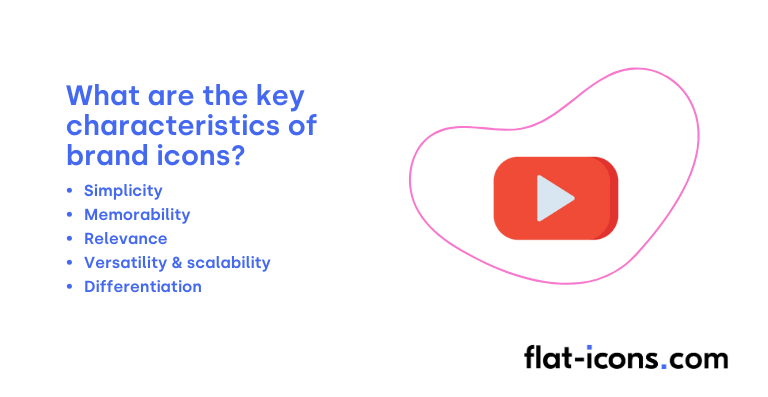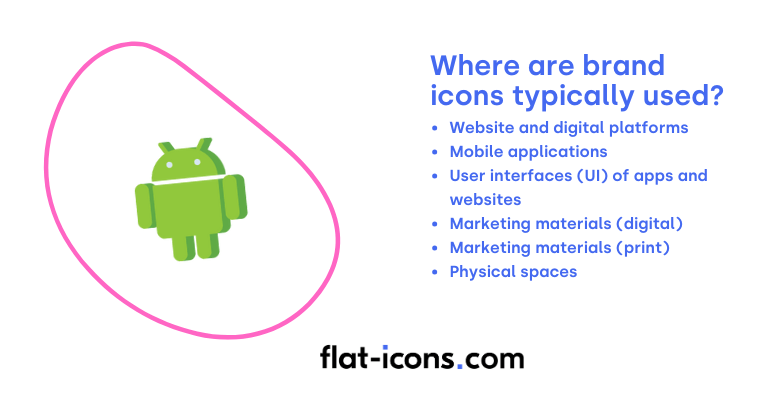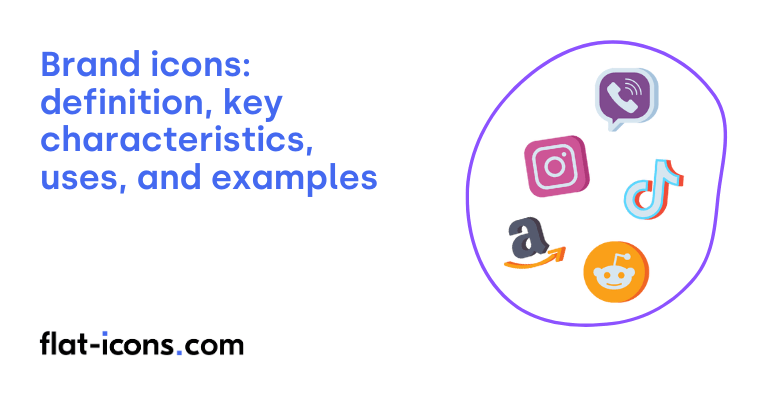Brand icons are digital icons that represent a company, product, or service’s brand identity through recognizable visual elements.
The key characteristics of brand icons are simplicity, memorability, relevance, versatility and scalability, and differentiation.
Brand icons are typically used in website and digital platforms, mobile applications, user interfaces (UI) of apps and websites, marketing materials (digital and print), and physical spaces.
Table of Contents
What are brand icons?
Brand icons are simplified, often standalone symbols that visually represent a brand. Frequently acting as condensed versions of a brand’s primary logo, these icons offer streamlined visual identifiers. They can include symbols, distinctive characters, animals, or any visual element embodying an organization’s culture, purpose, or unique aspects.
Strategically used across all brand communications, well-established brand icons trigger rational and emotional associations, shaping audience perception. Their role in consistently reinforcing brand presence in the digital landscape identifies them as a specific icon type. Brand icons can also visually represent processes or product features.
While “logo” and “icon” are often used interchangeably, a logo is typically a more comprehensive brand representation, whereas a brand icon is a specific, associated symbol.
What are the key characteristics of brand icons?

The key characteristics of brand icons are listed below.
- Simplicity: Effective brand icons have uncomplicated designs that are easily identifiable and versatile across various applications.
- Memorability: A successful brand icon has a unique feature that allows it to stand out and leave a lasting impression on viewers.
- Relevance: The brand icon appropriately represents the business and the industry, aligning with the brand’s personality and values.
- Versatility & scalability: A good brand icon functions seamlessly across a wide range of sizes and formats, maintaining its visual integrity in color or black and white.
- Differentiation: An effective brand icon is distinct from competitors, possessing a unique visual identity.
Where are brand icons typically used?

Brand icons are typically used as listed below.
- Website and digital platforms: Used for website navigation, favicons, and as profile pictures or identifiers on various social media platforms to establish a consistent online presence.
- Mobile applications: Serve as the primary app icon on home screens and within app stores, representing the brand at a glance and aiding user recognition.
- User interfaces (UI) of apps and websites: Integrated within the UI for various purposes like navigation, buttons, and representing specific brand-related features, enhancing brand visibility.
- Marketing materials (digital): Included in marketing emails, infographics, and digital advertisements to reinforce brand recognition and messaging across online campaigns.
- Marketing materials (print): Appear on business cards, stationery, merchandise, product packaging, and print advertisements to maintain brand consistency in tangible materials.
- Physical spaces: Used on storefront signs, stickers, promotional products, presentations, and internal communication platforms to establish a physical brand presence and reinforce identity.
When should you use brand icons?
You should use brand icons whenever you need a compact visual identifier for your brand, especially in situations where space is limited, such as within mobile app icons or on business cards. Their value lies in their ability to enhance brand recognition by providing an instant visual cue, often allowing for quick identification even without the full brand name present.
Brand icons offer valuable adaptability for diverse communication contexts, helping to maintain a consistent and professional appearance across various scenarios, from digital interfaces to printed materials. They can be particularly beneficial for service-based industries, such as finance and healthcare, where building trust and immediate recognition are crucial.
Strategically, the use of brand icons helps to reinforce your overall brand identity, simplify communication by providing a visual shorthand, and create an emotional connection with your target audience. The decision to implement a brand icon should involve careful consideration of your communication goals and the specific context in which it will be used, balancing the need for broad brand awareness with the desire for efficient user interaction.
What are the pros and cons of using brand icons?
The pros of using brand icons are listed below.
- Boost brand identity and recognition: Brand icons strengthen brand identity, improve recall, and create a consistent visual language.
- Improve communication and engagement: They aid in clear communication, break up text, and can forge an emotional connection with consumers.
- Provide a competitive advantage and versatility: Unique brand icons can differentiate a brand and are versatile for various content creation purposes.
- Increase credibility and professionalism: Consistent use of brand icons contributes to a more professional and credible brand image.
The cons of using brand icons are listed below.
- Require strong brand association and risk misinterpretation: Brand icons are most effective when the brand is already well-established, and there’s a risk users might misunderstand their meaning.
- Potential for high design costs and inconsistency: Professional design is usually necessary, and using generic or inconsistent icons can harm the brand.
- Risk of misalignment and becoming outdated: Icons must align with brand values and run the risk of feeling dated over time.
- Limited versatility in formal contexts: Brand icons might not be suitable for all formal or serious communication.
- Potential for cultural insensitivity: Care must be taken to ensure icons are appropriate and don’t cause offense across different cultures.
What are some examples of brand icons?
Some examples of brand icons are listed below.
- Apple’s bitten apple: A globally recognized symbol representing the technology company.
- Nike’s swoosh: A simple, dynamic mark that embodies the athletic brand.
- McDonald’s golden arches: The iconic “M” shape that is instantly associated with the fast-food chain.
- Google’s multicolored “G”: A playful and recognizable initial representing the search engine and technology giant.
- Starbucks’ siren: A mythical figure that has become synonymous with the coffeehouse company.
- Amazon’s arrow pointing from A to Z: Symbolizing the vast range of products available on their platform.
- Coca-Cola’s script logo: A classic and enduring handwritten-style wordmark.
- Twitter’s (X’s) bird (formerly): While now an “X”, the blue bird was a widely recognized symbol for the social media platform.
Read more icon articles
